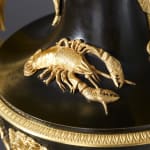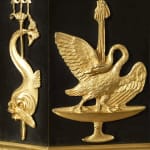Claude Galle
Further images
Literature
Hans Ottomeyer and Peter Pröschel, "Vergoldete Bronzen", 1986, p. 365, pl. 5.12.9, illustrating an identical pair of urns by Claude Galle sold by Sotheby's London, 25-26th June 1979, lot 129.
An extremely fine pair of Empire gilt and patinated bronze ewers by Claude Galle, each with a patinated tapering cylindrical body mounted with classical male nudes each with a tail and holding water pitchers, flanked by a naval trophy and surmounted around the collar by winged sea putti, the base of the neck mounted with lobsters below a dolphin-form spout with scale mounts around the rim, the handle composed of a beautiful winged classical maiden standing on a cornucopia-shaped pedestal, the fluted base of the urn on a grapevine ring, on a shaped plinth resting on an octagonal pedestal with canted corners mounted at the front with pairs of hippocampi flanking Neptune's trident, on the canted corners with a dolphin and trident and on the two ends with a swan, on a stepped and conformingly shaped base
Paris, date circa 1810
Height 82.5 cm. each.
Claude Galle (1759-1815) was one of the foremost bronziers and fondeur-ciseleurs of the late Louis XVI and Empire periods. Firstly patronised by the Garde-Meuble de la Couronne under Jean Hauré from 1786-88, he is known to have collaborated with Pierre-Philippe Thomire, amongst others, and was responsible for the majority of bronzes d'ameublement supplied during the Empire to Château de Fontainebleau. Among his distinguished repertoire were a number of urns, vases and even clock cases which as here had classical winged maidens surmounting or forming part of the handle. Examples include an attributed vase-shaped clock case of circa 1815 and a pair of corresponding vases, which as here are ornamented on the body with hippocampi mounts (illustrated ibid. p. 364, pl. 5.12.6), of which are related examples at Pavlovsk Palace, St. Petersburg, the Ostankino Palace, Moscow and another pair in the collection of the Earls of Essex, Cassiobury Park during the nineteenth century. Works of this type proved particularly popular among English collectors as well as those from Russia, where they were sometimes copied or inspired other luxury pieces by designers such as Andreï Voronikhin (1760-1814) and the bronzier Friedrich Bergenfeldt (1768-1822).
Galle was born at Villepreux near Versailles; during his youth he moved to Paris to begin an apprenticeship under the fondeur, Pierre Foy at rue du Four. In 1784 Galle married Foy's daughter, Marie-Elizabeth, when Foy died in 1788 Galle was required to pay off the elder's debts before taking over the workshop, which he built up into one the finest of its kind, eventually employing about 400 craftsmen. Galle moved the business to Quai de la Monnaie (renamed Quai de 1'Unité) and from 1805 operated from 60 Rue Vivienne, close to fellow fondeur, Pierre-Victor Ledure. From 1784 Galle began appearing in the trade registers; he became a maitre-fondeur in 1786 and in the same year received the first of many commissions from the Garde-Meuble to furnish the royal palaces, which in addition to Fontainebleau included the Châteaux de Saint-Cloud, Compiègne and Rambouillet, Le Palais des Tuileries, Les Trianons, as well as Monte Cavallo Rome and Stupinigi near Turin. Today Galle's work can be found amongst the world's finest collections, which in addition to the above include the Musée National de Chateau de Malmaison, the Musée Marmottan in Paris, the Museo de Reloges at Jerez de la Frontera, the Residenz Munich and the Victoria and Albert Museum in London.





